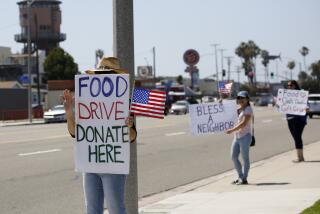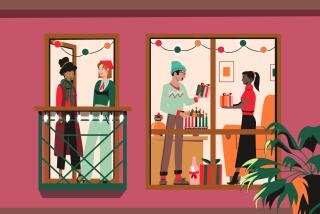Give till it hurts?
- Share via
Compassionate consumerism -- as some critics describe today’s hottest trend in philanthropy -- encourages people to feel socially conscientious while guiltlessly enjoying the good life. The idea is that you “give” by buying or selling a product, a portion of whose proceeds go to the needy. I don’t think so.
Parachute do-goodism is a little closer to a charitable ideal, but it still allows you to think you can succeed at saving the world merely by helping faraway strangers on a one-off spring break or during a gap year before college.
I thought about all of this last week when I learned that my friend, Sister Mary Rose Christy, had died. I wrote about her in this column four years ago, describing her as a “brusque, opinionated, hard-headed” woman who was nonetheless “the closest thing to a saint I [had] ever met.”
I’m one of those Catholics who believes the church should ordain women as priests and allow priests of either gender to marry and have families. (If the pedophile priest scandal taught us nothing else, it’s that the Roman Catholic Church needs to widen the universe of potential applicants to serve as shepherds to its flock.) But meeting people like Sister Mary Rose Christy, who took a vow of poverty, chastity and service in 1947 when she joined the Sisters of Mercy at
24 years old, also convinced me
of the good that’s possible in traditional Catholic religious orders. There is a powerful need for people to give their whole
lives to improving the lives of others.
It’s not for everybody. But neither is the life of an athlete or an astronaut. And like athletes and space explorers, nuns, monks and others who take religious vows can serve as examples of courage, discipline and excellence to the rest of us.
When I met Sister Mary Rose in Sibiu, Romania, 14 years ago, she was running a small nonprofit dedicated to supporting women and families and caring for orphans. Her work in Eastern
Europe was the final chapter in her long history of service to the disadvantaged. It began in
California and Arizona. As I
followed her on her daily routine,
I realized that in addition to her faith, it was the act of sacrificing a romantic life, a family and “getting ahead in the world” that enabled her to give so much of herself to others.
A different culture of service, the kind exemplified by Good Magazine and compassionate consumption, pushed the idea that charity can not only be hip but entirely compatible with living large or even getting rich -- no sacrifice necessary.
Of course, any form of charity is a good thing, but it’s important to remember that all forms aren’t equal. I wonder where Maimonides, the 12th century Spanish Jewish philosopher who articulated eight levels of charity -- selflessness and willingness to give are important markers for him -- would have put ecotourism or compassionate consumerism on his scale.
It’s easy enough to see that any cause is going to better served by those willing to sacrifice more than a few pennies in cost or profit in its pursuit, a la compassionate consumption. It’s easy enough to see that actively working for a cause is different -- and better -- than passively supporting it through what you buy. And it’s easy enough to see that real money or real time spent is genuine sacrifice -- you’ll have to surrender one thing for the sake of another that is more important.
The Sister Mary Rose Christys of the world, of course, happily surrender not just “more time” and “more money” but their whole lives to a cause. I fear that the culture of easy giving, however helpful, obscures our appreciation of that higher level and meaning of service and charity.
We understand the concept of “no pain, no gain,” when it refers to the sweat equity needed to physically get in shape. We should apply the same concept to the exercising of the heart that underlies our gifts to others. I’m not saying that real gifts require deep suffering, but the energy spent, the risk taken, the sacrifice made is commensurate with the love shared, the commitment made.
And ultimately those two elements, not a few heedless pennies for one product over another, are what makes the world a better place.
columnists.com


